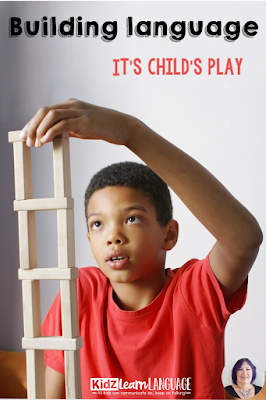I’ve written before on the importance of using play for building children’s language. Carol Westby has written a lot about the oral-literacy continuum, and the importance of children building scripts and schemas in play.
Toys that target language skills and motor skills, and build engagement are important for developing both cognitive and language skills. Westby (1980) wrote about the development of representational thought in children 18 months to 5-7 years.
While symbolic skills alone weren’t felt to be sufficient for language development, they were considered essential prerequisites for developing communication skills.
Westby developed a Symbolic Play Scale, based on research with “severely and trainable retarded children” and typically developing children; using 5 groups of toys. These included infant toys (pull and wind-up toys, busy boxes, etc), a household play area (with dolls and play-sized versions of household appliances and furnishings), a store area with relevant toys, a creative play area (with sandbox, trucks, puppets, and similar toys), and a gross motor area (with slide, riding toys, bowling set, etc).
Interpreting a child’s performance on a symbolic play assessment helped to drive goals for communication functions, semantic concepts, and syntactic structures. A cognitively based approach to language acquisition implied that language intervention only assisted a child in expressing what was already understood (Leonard, 1978).
When I was training in graduate school in the 1970’s Westby and Leonard, among others, were the go-to sources for child language development. And in 2006, Preissler concluded that for children with autism, “Play is an effective modality to teach children the precursors to symbolic thinking and the dynamics of social interaction”
In 2006, Berk et all also concluded “rich opportunities for make-believe….are among the best ways to ensure that young children acquire the self-regulatory skills essential for succeeding in school, academically and socially.”
More recently, however, research with children with complex communication needs and significant language disorders has shown that there are no prerequisites for communication development. Rather than waiting for a child to develop specific cognitive and symbolic skills, we now provide more consistent modeling of communication and language skills while playing with children to help build those symbolic skills and interaction skills.
Pat Ourand wrote “A belief by many is that since AAC is not always so simple, it must require significant cognitive and linguistic skills, which become imposed prerequisites that must be met before a child or adult can benefit from AAC. The National Joint Committee for the Communication Needs for Persons with Severe Disabilities (2003) published the Position statement on access to communication services and supports: Concerns regarding the application of restrictive "eligibility" policies. This paper states that, "eligibility for communication services and supports should be based on individual communication needs".
As well, research (see below) has dispelled the notion that communicators must somehow qualify for AAC interventions by showing certain precursor language or cognitive abilities, and this view is now extending into policy. In 2001, ASHA, with the work of Special Interest Division 12, AAC, adopted a statement on "No Prerequisites" for communication.”
She continues, “Lloyd and Kangas (1988), and others, have long countered this prerequisites-for-communication position with fact and rationales." These authors analyzed AAC research and concluded that cognitive prerequisites for communication were not required. "Specifically, they noted that withholding communication intervention until an individual develops specific presupposed cognitive or other prerequisites was unwise and not the best practice for then or now.”
Now, we support the participation-based model of communication rather than the cognitive-based model; and put an emphasis on building communication skills in AAC implementation, rather than focusing on areas of deficit.
The work of young children is play! Playing is how young children interact with and learn from the world. Building language skills in children does, indeed, involve a lot of play.
But building language through play involves more planning and thought than you might think. Play therapy involves creating an episode that unfolds; proceeds along a sequence, follows a set of actions that produces memorable experiences in the child's mind. These memories are what help to cement in the child's mind the language attached to them.
When using toys and games in therapy, we're always modeling the language we want to build, providing new vocabulary, expanding the child's responses to that next step up, and wearing that ever-popular "expectant look" that tells the child we're waiting for them to do/say something.
But play therapy does not only happen with young children. Many students with more complex needs - such as those with autism - often haven't had the same kinds of play experiences as their typical peers. They may not know how to play, and often have difficulty with the interactions involved in playing with another.
Over the next month - right up to those gift-giving holidays - I am going to focus on using toys to build language, and I will focus on open-ended play to build language; like this one,(affiliate link in image below) which can be used to play barrier games, to talk about shapes and colors, to build conversations around building designs and making pictures.
And if you have a 4-5 year old you want to be ready for kindergarten, try this resource, too.
You might like to read these related posts as well (there are 2 links here).
Ourand, P. (2010). Cognitive Prerequisites Not Required for AAC
Use. SpeechPathology.com
Westby, C.E. (1980). Assessment of Cognitive and Language Abilities through Play. Language, Speech, and Hearing Services in Schools, 11, 154-168.
Why is play important? http://www.children.gov.on.ca/htdocs/English/topics/earlychildhood/early_learning_for_every_child_t
oday.aspx



thanks for sharing such great information
ReplyDelete